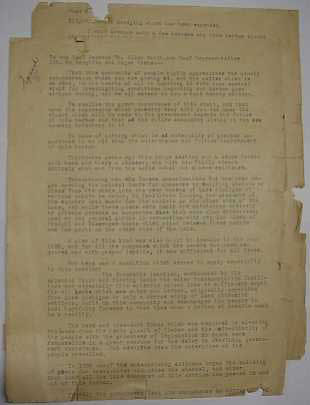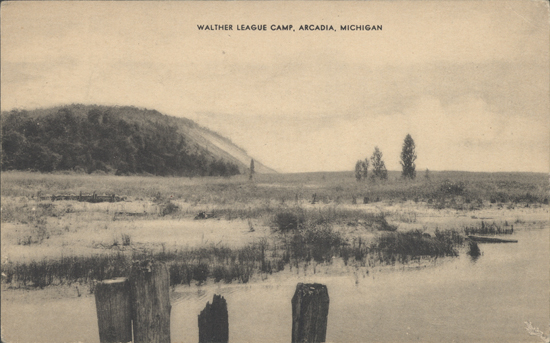The Channel Closes
Next | Previous | Return to Start
"You need $90,000 for repairs and $5,000/year for dredging."Based on the River and Harbor Act of 1902, the Army Corps of Engineers reviews Arcadia's harbor to estimate the cost of maintaining the piers and channel. The district officer of the Corp of Engineers reports that the existing harbor structures are inefficient and built of perishable varieties of timber, so for proper maintenance, both piers should be replaced and the north pier extended at a total cost of about $90,000. (The harbor was built and maintained privately from 1892 through 1906 for about $75,000.) After reviewing this report, the Board of Engineers of Rivers and Harbors agrees with the district officer that the expenditure of $90,000 plus $5,000 annually for maintenance is justified by the amount of local commerce. "But we recommend only $3,000 per year for dredging."In spite of their own recommendations, the Board of Engineers advises congress to approve spending only $3,000 per year for five years to simply dredge the channel without making any repairs to the piers. Congress approves this appropriation, and from 1905 through 1909 the channel is dredged, but no repairs are made to the piers. The Channel DeterioratesNothing is done to maintain or repair the piers. Sand taken out of the channel is soon replaced by sand washing through defective portions of the pier. Boats have trouble using the channel even in calm weather. The channel is unfit for boats trying to make regular trips. Based on the River and Harbor Act of 1909, the harbor is reviewed again. Large fires had destroyed practically all of the local manufacturing plants, but they were slowly being rebuilt. Severe drought had destroyed nearly all crops. Because of these natural disasters and poor harbor maintenance, commerce has declined, and because of this lack of commerce, the Corp of Engineers recommends against further maintenance. |
In 1905 the federal government begins maintaining the channel. However, money is appropriated to dredge the channel but not make any repairs to the piers. Not surprisingly, the channel is frequently closed. Sand taken out of the channel is almost immediately replaced by sand washing in through defective portions of the pier. As the piers deteriorate, the problem grows worse. It is difficult to enter the channel in calm weather and impossible in bad weather. Eventually the channel is closed more than it is open, and ships stop coming to Arcadia. In spite of a long period of lobbying by local citizens and representatives in congress and occasional stopgap appropriations, funding stops reportedly because of the channel's lack of use for local commerce. |
The Fight for the ChannelIn 1910, representatives from Arcadia convince Major Kellor that his unfavorable report should be revised. He agrees to change the report when he can and recommend $5,000 per year for dredging and additional funds for repairing the south pier. He also recommends to the delegation that they secure a hearing in Washington, D.C. Hearings before the Board of Engineers on Rivers and Harbors in Washington, D.C. and before the House Committee on Rivers and Harbors go nowhere. However, with the help of local senators, the delegation secures an amendment to the River and Harbor bill in the Senate, which appropriates $20,000 to carry out Major Kellor's promise. Unfortunately, in a conference between members of both houses, the amendment is stricken from the bill because of the unfavorable report on the harbor. A request for another inspection of the harbor is granted. The people of Arcadia and their government representatives prepare to make a good impression on Major C.S. Riche from the Corp of Engineers in Detroit by organizing presentations and samples of local products intended to bolster their claims about the harbor's value to local commerce. However, Major Riche arrives late to the inspection, skips the presentations by local business people and politicians, and heads back to Detroit early. Major Riche delivers an unfavorable report. Without the support of the Corp of Engineers, Senator Smith secures $10,000. In 1912, through the persistence of the Arcadia Developmental Association and Senator Smith, Arcadia receives $20,000 for harbor improvement. In 1913, the piers are repaired but not lengthened. Most of the superstructure of the north pier has washed away. The end of the south pier is broken. Additional money for harbor repairs is requested, but aid is increasingly difficult to get, because the harbor is blacklisted by the Corp of Engineers. The Inevitable HappensIn 1925, a public notice from the United States Engineer Office in Milwaukee states that as a result of a preliminary investigation, the War Department is considering whether to recommend abandonment of the project to improve Arcadia's harbor. Reason: Lack of commerce using the improvement. Charles Starke argues that the lack of commerce is due to the neglect of the government to keep the harbor open. He also stresses Arcadia's role in tourism, with 800 summer visitors requiring housing and hotel accommodations and with the Lutheran Walther League's large summer camp. |
|
|
Because access to Arcadia's harbor is unreliable, shipping drops off. Because Arcadia is no longer the active port it used to be, all funding for dredging and pier maintenance stops. The channel closes and remains that way until 1961. A Bright FutureIn 1961, the Township of Arcadia, with financial assistance from the Waterways Commission and the Accelerated Public Works Program of the Federal Government, reopens the channel between Bar Lake and Lake Michigan and rebuilds the piers. ... but that's another story. |
|

